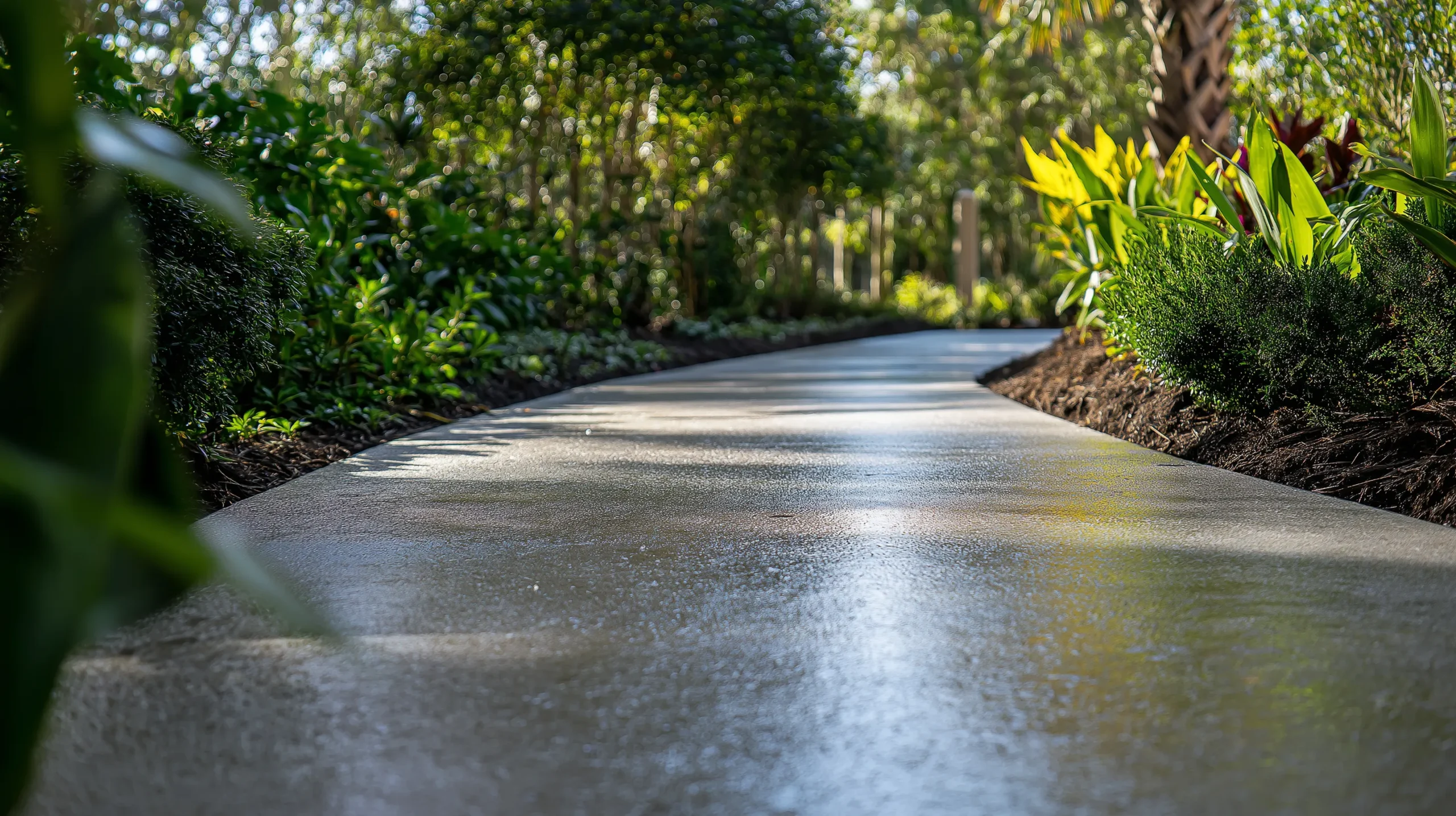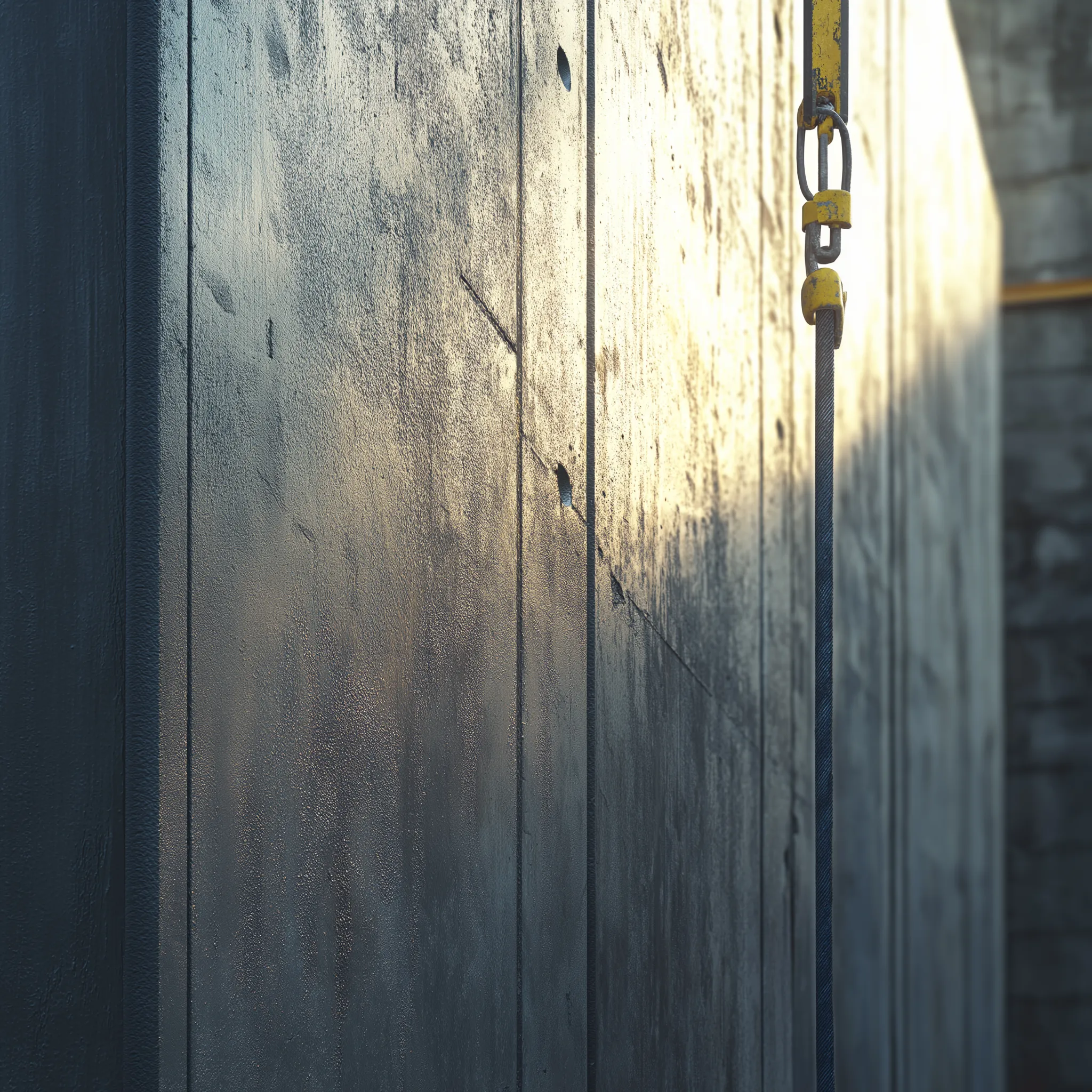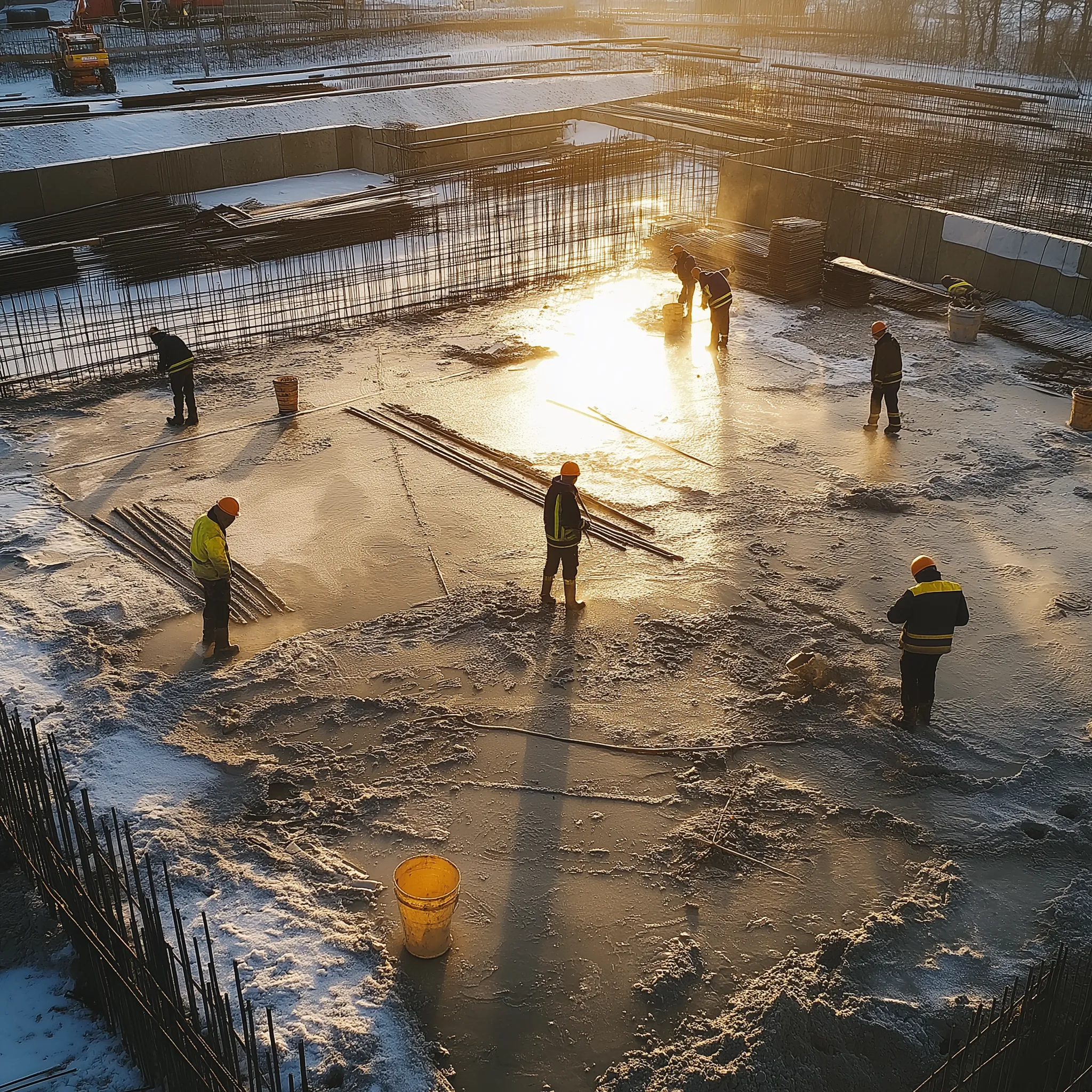The Problem: Spalling
Concrete spalling is a concerning issue faced in many construction and structural applications. Spalling refers to the breaking, chipping, or flaking of the concrete surface, often leading to exposure of the inner aggregates and potential compromise of the structure’s integrity. Understanding the primary causes of spalling is essential for implementing effective preventative and repair measures.
Causes of Concrete Spalling
- Freeze-Thaw Cycles:
- Description: Water that infiltrates the concrete can freeze and expand in cold temperatures, leading to surface flaking and breaking over time as the cycle repeats.
- De-icing Salts:
- Description: The use of de-icing salts accelerates the freeze-thaw damage by lowering the freezing point of water, leading to increased cycles of freezing and thawing within the concrete pores.
- Improper Pouring/Finishing:
- Description: Poor finishing techniques or improper concrete pouring can lead to weak surface layers. These weak layers are more susceptible to spalling when exposed to environmental stressors.
- Corrosion of Embedded Metals:
Description: Reinforcing steel within the concrete can corrode due to exposure to moisture and chlorides. This corrosion can cause expansion, leading to internal pressure and subsequent spalling of the concrete.
The Solution
Preventative Measures
Addressing the root causes of spalling is crucial in preventing its occurrence. The following preventative measures are recommended:
- Proper Mix Design:
- Ensure the concrete mix has adequate air entrainment to accommodate freeze-thaw effects. Use high-quality aggregates and suitable water-cement ratios to enhance durability.
- Effective Curing:
- Proper curing techniques maintain appropriate moisture and temperature levels, strengthening the surface and reducing susceptibility to spalling.
- Surface Protection:
- Applying surface sealants can provide a protective barrier against moisture and de-icing salts, minimizing the exposure of concrete to these damaging elements.
- Reinforcement Protection:
- Utilizing corrosion inhibitors within the concrete mix or applying protective coatings to the steel reinforcement can prevent corrosion-related spalling.
Repair Methods
When spalling occurs, repairing the affected areas promptly can restore the concrete surface and prevent further deterioration:
- Surface Patching:
- Remove loose and damaged concrete, and apply high-quality repair mortars or overlays to restore the surface. Ensure proper bonding by cleaning and preparing the substrate thoroughly.
- Corrosion Treatment:
- Treat the exposed and corroded reinforcing steel to halt the corrosion process before applying repair materials.
The SpecChem Solution
SpecChem offers a robust lineup of products designed to both prevent and repair concrete spalling efficiently.
Prevention and Protection
- SpecShield / All Shield
- Description: These advanced waterproofing and sealing solutions penetrate the concrete surface, forming a protective barrier.
- How It Helps: By preventing water and de-icing salts from infiltrating the concrete, these products reduce the risk of freeze-thaw damage and subsequent spalling.
- Curing and Sealing/Decorative Sealing Products
- Description: A range of products designed to cure and seal concrete, providing a protected and aesthetically pleasing finish.
- How They Help: These products help maintain proper moisture levels during the curing process, which strengthens the concrete surface and reduces susceptibility to spalling. They also add a layer of protection against environmental stressors.
Repair Products
- RepCon V/O
- Description: A high-performance repair mortar for vertical and overhead applications.
- How It Helps: Repairs spalled concrete by providing a robust and lasting surface finish, effectively restoring damaged areas.
- RepCon 928
- Description: A versatile repair mortar suitable for various concrete repair applications.
- How It Helps: Quickly and effectively repairs spalled sections, restoring the structural integrity of the concrete surface.
- Duo Patch
- Description: A dual-component patching compound for repairing and renewing concrete surfaces.
- How It Helps: Provides a durable repair solution for spalled concrete, ensuring a smooth and resilient finish.
- OverCrete
- Description: A one-component, polymer-modified concrete repair/resurfacing mortar A concrete overlay system used to resurface and repair damaged concrete.
- How It Helps: Covers and repairs cracked and spalled concrete surfaces, providing a fresh, durable, and aesthetically appealing finish.
SpecChem’s targeted solutions offer reliable ways to prevent and repair concrete spalling, ensuring the durability and longevity of your concrete structures.
FAQs on Concrete Spalling
1. What causes concrete spalling? Concrete spalling is caused by freeze-thaw cycles, the use of de-icing salts, improper pouring/finishing, and corrosion of embedded metals.
2. How can I prevent concrete spalling? Prevent concrete spalling by using a proper mix design, effective curing techniques, applying surface sealants, and protecting steel reinforcement with corrosion inhibitors.
3. Can spalled concrete be repaired? Yes, spalled concrete can be effectively repaired using surface patching techniques and high-quality repair mortars, following careful preparation and cleaning of the affected areas.
4. What are the best products for preventing spalling? SpecChem offers several highly effective products for preventing concrete spalling. Our SpecShield and All Shield sealants penetrate concrete surfaces to form protective barriers against moisture and de-icing salts, reducing the risk of freeze-thaw cycles that cause spalling. Additionally, our range of curing and sealing/decorative sealing products help maintain proper moisture levels during the curing process and add a layer of protection against environmental stressors, further preventing spalling.
5. How do freeze-thaw cycles cause spalling? Freeze-thaw cycles cause spalling by allowing water trapped within the concrete to freeze and expand, creating internal stress that breaks and chips the concrete surface.
6. Are de-icing salts harmful to concrete? Yes, de-icing salts can accelerate freeze-thaw damage and promote corrosion of embedded metals, leading to increased spalling.
7. What is the role of air entrainment in preventing spalling? Air entrainment in the concrete mix helps accommodate the expansion of freezing water, reducing the risk of freeze-thaw damage and subsequent spalling.
8. What products does SpecChem offer for repairing spalled concrete? SpecChem offers a range of products like RepCon V/O, RepCon 928, Duo Patch, and OverCrete to effectively repair and protect spalled concrete surfaces.
Concrete spalling is a prevalent issue that can compromise the durability and aesthetics of concrete structures. By understanding the main causes and implementing both preventative and repair measures, you can maintain resilient and long-lasting concrete surfaces. SpecChem’s comprehensive selection of products provides reliable solutions tailored to address and mitigate concrete spalling, ensuring the sustainability and performance of your construction projects.
Additional FAQ
What causes spalling in concrete?
Spalling in concrete is caused by environmental and material factors that lead to the breaking, chipping, or flaking of the concrete surface. Common causes include freeze-thaw cycles, the use of de-icing salts, inadequate curing, improper pouring or finishing techniques, and corrosion of embedded metals.
How does freeze-thaw cycling contribute to spalling?
Freeze-thaw cycling contributes to spalling by causing water trapped within the concrete to freeze and expand in cold conditions. This expansion creates internal stress, leading to the breaking and chipping of the concrete surface over repeated cycles. Proper mix design and curing can mitigate freeze-thaw damage.
Can de-icing salts lead to concrete spalling?
Yes, de-icing salts can accelerate concrete spalling. These salts lower the freezing point of water, increasing freeze-thaw cycles within the concrete. They also pose a risk to embedded metals, promoting corrosion and further contributing to spalling.
What are the signs of spalling in concrete?
Signs of spalling in concrete include:
- Chipping or Flaking: Visible fragments breaking away from the surface.
- Pitted Surfaces: Small craters or dips on the concrete surface.
- Discoloration: Dark spots or surface rust indicating underlying corrosion.
- Exposed Aggregates: The exposure of coarse aggregates as the surface layer deteriorates.
How can improper pouring or finishing cause spalling?
Improper pouring or finishing can cause spalling by creating weak surface layers. Over-troweling, adding excess water during finishing, or inadequate compaction can all lead to a compromised surface that is more susceptible to environmental stressors like freeze-thaw cycles and de-icing salts.
What role does metal corrosion play in concrete spalling?
Metal corrosion plays a significant role in concrete spalling. When embedded metal reinforcing bars corrode, they expand, creating internal stress and causing the surrounding concrete to crack and spall. Chlorides from de-icing salts or seawater accelerate the corrosion process.
Can spalling concrete be repaired?
Yes, spalling concrete can be effectively repaired using various methods such as:
- Surface Cleaning: To remove loose material and contaminants.
- Application of Repair Mortars: High-performance repair mortars that bond well with existing concrete.
- Surface Sealers: To protect the repaired areas from further environmental damage.
What are the best methods to prevent concrete spalling?
Preventing concrete spalling involves several best practices:
- Proper Mix Design: Using air-entrained concrete to resist freeze-thaw cycles.
- Effective Curing: Ensuring uniform hydration to strengthen the surface.
- Surface Sealers: Applying sealers to protect against moisture and de-icing salts.
- Adequate Compaction and Finishing: Ensuring a strong, dense surface layer.
How does spalling affect the durability of concrete?
Spalling affects the durability of concrete by exposing deeper layers to environmental stressors, enabling moisture and contaminants to penetrate. This can lead to further deterioration, corrosion of reinforcement, and ultimately a reduction in the structural integrity and lifespan of the concrete.
What materials can be used to repair spalled concrete?
Materials used to repair spalled concrete include:
- Repair Mortars: Such as high-performance products like RepCon V/O, RepCon 928, or Duo Patch.
- Concrete Overlays: For extensive repairs to restore the surface.
- Surface Sealers: To protect the repaired areas from environmental damage.
Is spalling a common problem in cold climates?
Yes, spalling is particularly common in cold climates due to frequent freeze-thaw cycles and the use of de-icing salts. The harsh conditions accelerate the deterioration process, making preventive measures and proper concrete maintenance critical.
Can sealing concrete prevent spalling?
Sealing concrete can effectively prevent spalling by creating a protective barrier against moisture and de-icing salts. Sealers reduce the penetration of water and chlorides, minimizing the risk of freeze-thaw damage and corrosion of embedded metals.
How quickly can spalling spread in concrete structures?
The rate at which spalling spreads depends on several factors, including the severity of environmental conditions, the quality of the concrete, and the extent of preventive measures in place. In harsh conditions without intervention, spalling can spread quickly and compromise structural integrity.
What are the long-term effects of untreated spalling?
Untreated spalling can lead to severe long-term effects, including:
- Compromised Structural Integrity: Due to further cracking and deterioration.
- Corrosion of Reinforcement: Accelerating internal damage.
- Reduced Lifespan: Of the concrete structure as it becomes increasingly vulnerable to environmental stressors. Addressing spalling early is crucial to maintaining the safety and durability of the structure.
How can you identify the early signs of concrete spalling?
Early signs of concrete spalling include:
- Surface Flaking or Chipping: Small areas beginning to break away.
- Pitting: Minor craters or dips on the concrete surface.
- Discoloration: Spots or streaks that indicate underlying issues.
- Hairline Cracks: Small cracks that may widen over time. Recognizing and addressing these signs early can prevent more severe deterioration.





